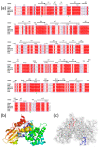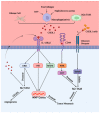Potential Roles and Future Perspectives of Chitinase 3-like 1 in Macrophage Polarization and the Development of Diseases
- PMID: 38003338
- PMCID: PMC10671302
- DOI: 10.3390/ijms242216149
Potential Roles and Future Perspectives of Chitinase 3-like 1 in Macrophage Polarization and the Development of Diseases
Abstract
Chitinase-3-like protein 1 (CHI3L1), a chitinase-like protein family member, is a secreted glycoprotein that mediates macrophage polarization, inflammation, apoptosis, angiogenesis, and carcinogenesis. Abnormal CHI3L1 expression has been associated with multiple metabolic and neurological disorders, including diabetes, atherosclerosis, and Alzheimer's disease. Aberrant CHI3L1 expression is also reportedly associated with tumor migration and metastasis, as well as contributions to immune escape, playing important roles in tumor progression. However, the physiological and pathophysiological roles of CHI3L1 in the development of metabolic and neurodegenerative diseases and cancer remain unclear. Understanding the polarization relationship between CHI3L1 and macrophages is crucial for disease progression. Recent research has uncovered the complex mechanisms of CHI3L1 in different diseases, highlighting its close association with macrophage functional polarization. In this article, we review recent findings regarding the various disease types and summarize the relationship between macrophages and CHI3L1. Furthermore, this article also provides a brief overview of the various mechanisms and inhibitors employed to inhibit CHI3L1 and disrupt its interaction with receptors. These endeavors highlight the pivotal roles of CHI3L1 and suggest therapeutic approaches targeting CHI3L1 in the development of metabolic diseases, neurodegenerative diseases, and cancers.
Keywords: CHI3L1; cancers; diseases; inhibitors; macrophage polarization.
Conflict of interest statement
The authors declare no conflict of interest.
Figures




Similar articles
-
Astrocytic Chitinase-3-like protein 1 in neurological diseases: Potential roles and future perspectives.J Neurochem. 2023 Jun;165(6):772-790. doi: 10.1111/jnc.15824. Epub 2023 Apr 26. J Neurochem. 2023. PMID: 37026513 Review.
-
Significance of chitinase-3-like protein 1 in the pathogenesis of inflammatory diseases and cancer.Exp Mol Med. 2024 Feb;56(1):1-18. doi: 10.1038/s12276-023-01131-9. Epub 2024 Jan 4. Exp Mol Med. 2024. PMID: 38177294 Free PMC article. Review.
-
Roles of chitinase 3-like 1 in the development of cancer, neurodegenerative diseases, and inflammatory diseases.Pharmacol Ther. 2019 Nov;203:107394. doi: 10.1016/j.pharmthera.2019.107394. Epub 2019 Jul 26. Pharmacol Ther. 2019. PMID: 31356910 Review.
-
Inflammatory Effects and Regulatory Mechanisms of Chitinase-3-like-1 in Multiple Human Body Systems: A Comprehensive Review.Int J Mol Sci. 2024 Dec 15;25(24):13437. doi: 10.3390/ijms252413437. Int J Mol Sci. 2024. PMID: 39769202 Free PMC article. Review.
-
Potential role of chitinase-3-like protein 1 (CHI3L1/YKL-40) in neurodegeneration and Alzheimer's disease.Alzheimers Dement. 2023 Jan;19(1):9-24. doi: 10.1002/alz.12612. Epub 2022 Mar 2. Alzheimers Dement. 2023. PMID: 35234337 Free PMC article.
Cited by
-
Chitinase-3-like-1: a multifaceted player in neuroinflammation and degenerative pathologies with therapeutic implications.Mol Neurodegener. 2025 Jan 18;20(1):7. doi: 10.1186/s13024-025-00801-8. Mol Neurodegener. 2025. PMID: 39827337 Free PMC article. Review.
-
Chitinase-3 Like-Protein-1 Signature in Neurological Disorders: Emphasis on Stroke.J Mol Neurosci. 2025 Feb 20;75(1):25. doi: 10.1007/s12031-025-02311-0. J Mol Neurosci. 2025. PMID: 39976746 Review.
-
Glial Cells as Key Regulators in Neuroinflammatory Mechanisms Associated with Multiple Sclerosis.Int J Mol Sci. 2024 Sep 4;25(17):9588. doi: 10.3390/ijms25179588. Int J Mol Sci. 2024. PMID: 39273535 Free PMC article. Review.
-
Macrophages as Potential Therapeutic Targets in Acute Myeloid Leukemia.Biomedicines. 2024 Oct 11;12(10):2306. doi: 10.3390/biomedicines12102306. Biomedicines. 2024. PMID: 39457618 Free PMC article. Review.
-
miPEP31 alleviates sepsis development by regulating Chi3l1-dependent macrophage polarization.Biol Direct. 2024 Nov 18;19(1):117. doi: 10.1186/s13062-024-00568-w. Biol Direct. 2024. PMID: 39558383 Free PMC article.
References
-
- van Eijk M., van Roomen C.P., Renkema G.H., Bussink A.P., Andrews L., Blommaart E.F., Sugar A., Verhoeven A.J., Boot R.G., Aerts J.M. Characterization of human phagocyte-derived chitotriosidase, a component of innate immunity. Int. Immunol. 2005;17:1505–1512. doi: 10.1093/intimm/dxh328. - DOI - PubMed
-
- Volck B., Price P.A., Johansen J.S., Sørensen O., Benfield T.L., Nielsen H.J., Calafat J., Borregaard N. YKL-40, a mammalian member of the chitinase family, is a matrix protein of specific granules in human neutrophils. Proc. Assoc. Am. Physicians. 1998;110:351–360. - PubMed
Publication types
MeSH terms
Substances
LinkOut - more resources
Full Text Sources
Medical
Research Materials

